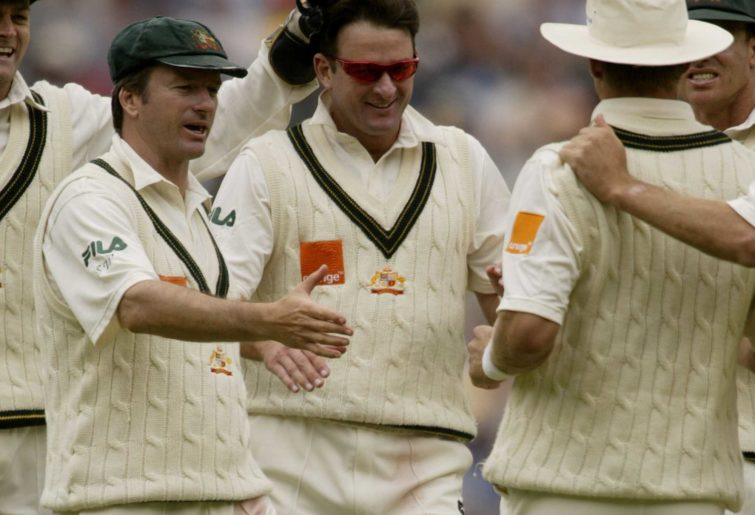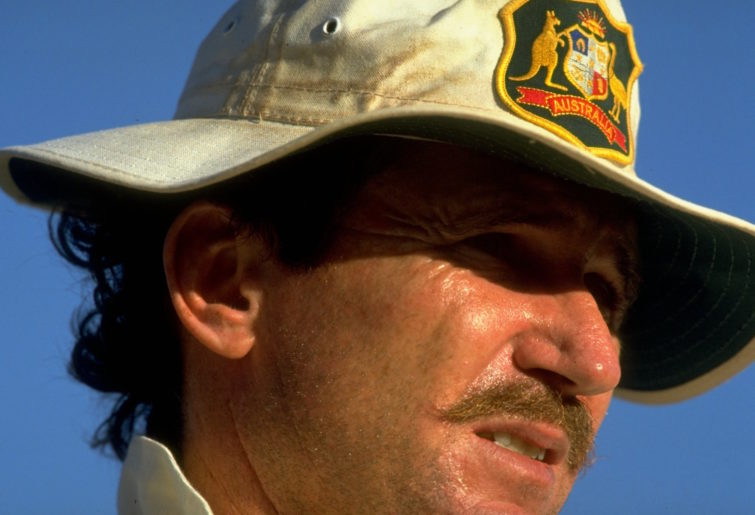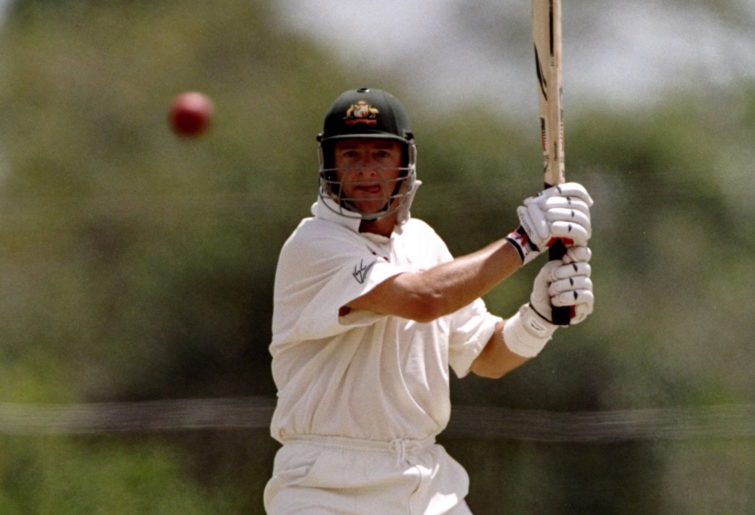For Ashes cricket comparisons between the Waughs, peers have to be included because Mark and Steve did not stand out from the pack compared to when playing the West Indies, South Africa and Pakistan.
This is more due to the fact that England’s bowlers were not in the same league, rather than the specialness of Ashes cricket.
Because of the humungous amount of capping that needs to be done, I have restricted the comparison to six other players. The players chosen were the seven who performed the best among the ones who played in the largest number of matches plus long serving wicketkeeper Ian Healy.
For players such as Allan Border and Ricky Ponting, only series played between 1986 and 2001 were considered, and for this reason Ponting doesn’t make the cut under the aforementioned criteria.
The parameters are the same as for the West Indies, South Africa and Pakistan except that for Ashes cricket I am pretty much completely unconcerned with dead rubbers. There are three main reasons for this.

(Credit: Sean Garnsworthy/Getty Images)
Firstly, Australia lost only one solitary Test across eight series between 1989 and 2003 inclusive when the destiny of the Ashes had not yet been decided and that was the first Test of the 1997 series in the middle of the saga of Mark Taylor’s infamous but somewhat overplayed form slump.
Secondly, for the eight players listed in the table below, there is only one whose statistics suffer even remotely significantly when dead rubbers are taken out of the equation, and no prizes for guessing who that might be.
In fact, in the period under discussion (1986-2001), Ricky Ponting was the only player who ever excelled in dead rubbers after not performing at all in the front end of the series when it really mattered – that was 2001 and his era of dominance with the bat would begin the very next series in 2002-03 when the Waugh era was as good as over.
Thirdly, Australia’s ruthless Ashes dominance actually began with a consolation, morale-boosting dead rubber win after losing the first of the series under discussion, in Sydney in January 1987.
That Sydney win was also a watershed for Australia for two other completely non-Ashes related reasons. One, it marked a turnaround of Australia’s Test fortunes after three consecutive summers of constant trauma and two, it was actually the first Test match win full stop for seven of the 11 who played in that Test.
Four of those players – Steve Waugh, Merv Hughes, Geoff Marsh and Bruce Reid – had all debuted more than a year previously, while a fifth, Dean Jones, had debuted nearly three years earlier.
In fairness to ‘Dead Rubber Deano’, if for four of those five reasons outlined above we simply consider that aforementioned Sydney win as an honorary non-dead rubber, his meaningful average ignoring all other dead rubbers finishes only three and a half runs lower than his meaningful average when including all Ashes Tests while his first-innings average for non-dead rubbers would actually exceed his overall first-innings average by more than 20 per cent at a neat 80.
This does require quite a large grain of salt though, which will be outlined later.
I am going to struggle with the word limit here, so I need to ascertain the omissions and capping that needs to be done.
Days 2-5 of the third Test of the 1986-87 series will be completely ignored. This was a match in which a mere 20 wickets fell across five full days for around 1200 runs. The only relevance is that no collapse occurred on the first day, as in fact it did on the same ground four years later.
Therefore, Dean Jones’ 93 will be treated as 27 not out, Allan Border’s 70 will be treated as 19 not out while David Boon retains his 103.

(Photo by Ryan Pierse/Getty Images)
There are four lost-cause innings to omit and they are the third innings in Brisbane in 1986-87, the third innings in Melbourne in 1986-87, the fourth innings at the Oval in 1993 and the third innings at Edgbaston in 1997.
There are only two innings where all who batted are to be treated as zero not out, on account of being a fourth innings where the target was not being chased, and they survived for a hard fought, honourable draw when losing was a real possibility, and they are in Perth in 1986-87 and at Trent Bridge in 1993.
So now to the capping, and you will notice that there is none in the first of these series under discussion, that is 1986-87:
• First innings (of match) at Headingley in 1989, Steve Waugh capped at 150.
• Third innings at Headingley in 1989, all batsmen capped at 20.
• Fourth innings at Lord’s in 1989, Mark Taylor and David Boon capped at 25, Steve Waugh capped at 15.
• Third innings at Edgbaston in 1989, completely ignored.
• Fourth innings at Old Trafford in 1989, Mark Taylor capped at ten, David Boon’s runs ignored.
• First innings (of match) Trent Bridge in 1989, Mark Taylor capped at 100, David Boon capped at ten, all other runs ignored.
• Third innings at the Oval in 1989, all batsmen capped at 25.
• Fourth innings in Brisbane in 1990-91, both openers capped at 20.
• Fourth innings in Melbourne in 1990-91, both not-out batsmen capped at 30.
• Third innings in Adelaide in 1990-91, David Boon capped at 100, Allan Border capped at 50.
• Fourth innings in Perth in 1990-91, all three batsmen capped at 12.
• Third innings at Old Trafford in 1993, David Boon and Mark Waugh capped at 50, Steve Waugh capped at 30, Ian Healy capped at 25.
• First innings (of match) at Lord’s 1993, Mark Taylor and Michael Slater capped at 100, David Boon and Mark Waugh at 75, Allan Border at 50, Steve Waugh’s runs completely ignored
• First innings (of match) at Headingley in 1993, David Boon capped at 85, Allan Border and Steve Waugh capped at 75.
• Third innings in Brisbane in 1994-95, Mark Taylor and Michael Slater capped at 30, all other batsmen capped at 15.
• Third innings in Melbourne in 1994-95, David Boon capped at 50, Steve Waugh’s and Ian Healy’s runs completely ignored.
• Fourth innings in Sydney and Adelaide in 1994-95, in both instances, I am counting the scores of all of the one-to-six batsmen, but ignoring Healy’s innings in both instances.
• Third innings at Perth in 1994-95, Mark Taylor and Michael Slater capped at 35, Steve Waugh and Greg Blewett capped at 25.
• Third innings at Old Trafford in 1997, all batsmen capped at 55.
• Third innings at Trent Bridge in 1997, Mark Taylor, Matthew Elliott and Greg Blewett all capped at 30, Ian Healy capped at 20.
• Third innings in Brisbane in 1998-99, Michael Slater and Justin Langer capped at 35, Mark Waugh at ten and Steve Waugh at five.
• Fourth innings in Perth in 1998-99, all batsmen capped at seven.
• Third innings in Adelaide, Michael Slater capped at 50, Mark Waugh at ten.
• Second innings (of match) at Edgbaston in 2001, Steve Waugh capped at 90.
• Fourth innings at Trent Bridge in 2001, Matthew Hayden capped at 25, Mark Waugh and Damien Martyn capped at 20.
• First innings (of match) at the Oval in 2001, both Waughs capped at 100.
Now to the actual table below, after which I will finish by mentioning a few relevant things about each of the eight players listed therein. Tables are so cool!
| Batsman |
Meaningful innings |
First-innings average |
Meaningful average |
Strike rate* |
100s |
50s |
| Mark Waugh |
48 |
56.1 |
47.2 |
59.2 |
6 |
11 |
| Excluding dead rubbers |
40 |
52.4 |
45.3 |
59.2 |
4 |
10 |
| Steve Waugh |
54 |
60.3 |
47.6 |
49.1 |
9 |
10 |
| Excluding dead rubbers |
45 |
63.5 |
50.1 |
50.2 |
8 |
9 |
| Allan Border |
30 |
54 |
48.2 |
43.7 |
2 |
9 |
| Excluding dead rubbers |
24 |
56.2 |
50 |
43.6 |
2 |
8 |
| Dean Jones |
22 |
66.9 |
58.2 |
52.9 |
3 |
6 |
| Excluding dead rubbers |
17 |
50.7 |
48.2 |
56 |
1 |
5 |
| Michael Slater |
35 |
47.4 |
39.2 |
53.1 |
7 |
3 |
| Excluding dead rubbers |
31 |
53 |
42.9 |
54.5 |
7 |
3 |
| David Boon |
43 |
44.6 |
43.2 |
41.5 |
6 |
6 |
| Excluding dead rubbers |
37 |
46.8 |
44.4 |
42.3 |
6 |
5 |
| Mark Taylor |
51 |
48.5 |
35.9 |
40.8 |
5 |
12 |
| Excluding dead rubbers |
44 |
42.5 |
32.9 |
39.2 |
4 |
10 |
| Ian Healy |
40 |
25.6 |
26.6 |
55.9 |
2 |
6 |
| Excluding dead rubbers |
34 |
21.3 |
23.6 |
52.6 |
2 |
4 |
*Strike rate (linked directly/entirely to meaningful average)
Allan Border
Border played consistently across all four series he was involved in during the Waugh era. His best achievements would be his 125 in the second Test of the 1986-87 series to give Australia an even chance of avoiding defeat so as to not be down 0-2 after two Tests, as well as his 66 on the first day of the 1989 series.

(Credit: Ben Radford/Allsport via Getty Images)
On that first day in the aforementioned 1989 series, he came in at 2-57 in not overly batting friendly conditions and played aggressively to negate the advantage held by the bowlers.
His strike rate was a dozen or so runs higher than his normal rate of scoring and the way he played left Australia well placed on 3-207 at the end of a significantly shortened first day’s play, also enabling rookie opener Mark Taylor to go to stumps within a boundary of a maiden Test century.
Border was obviously captain for all four of these series he played in, but this article focuses exclusively on batting.
Mark Taylor
Taylor enjoyed more than a few fine moments over six Ashes series without being on the losing side once, including three as captain.
Only days after his second-innings 113 in Sydney in 1994-95, which in a 208-run opening stand with Slater, gave Australia a sniff of a world record 449 fourth-innings chase, Taylor said he rated it among his best innings simply because it was almost mistake free.
Taylor enjoyed a productive series in that same first one as captain, leading from the front with other scores of 90 in Adelaide in reply to England’s first-innings 419 as well as 59 on the opening day of the series.
His second-innings 58 in the third innings of that same first Test contained about 30 runs that were extremely beneficial to the team cause of setting an unreachable target for the opposition while also leaving his bowlers plenty of time to bowl them out a second time.

(Credit: Mike Hewitt /Allsport/Getty Images)
Contrary to popular belief, his 129 in his team’s second innings in the first Test of 1997 did not end his form slump, as it was played with a nothing-to-lose mentality in a completely lost cause, 378 behind on the first dig.
His opening-day 76 in the Ashes- and series-sealing fifth Test and then 45 in the third innings of the match, of which about 30 where relevant to the team cause, was actually where his real return to form began. In between, his form in Tests 2-4 was as woeful as it had been all calendar year.
In his final Ashes series in 1998-99, he made extremely valuable first-innings contributions of 46, 61 and 59 towards Australia once again retaining the Ashes with two Tests to play. His only genuinely poor Ashes series was in 1990-91 where he made an extremely mediocre 99 runs in five first innings.
Michael Slater
Slater played in four Ashes series, two home and two away, and Australia won all of them. He blazed onto the scene like a glorious comet in 1993, and was probably Australia’s best batsman in the 1994-95 series, narrowly shading Mark Waugh and skipper Taylor.
However, official statistics make his 1998-99 series look considerably better than what it actually was, even if his 123 in Sydney in Australia’s final innings of the series was undeniably absolutely priceless.

(Photo by Andy Kearns/Getty Images)
However, his other two second-innings centuries have been legitimately capped at 35 and 50, and his five first innings that series yielded a mere 86 runs with a top score of 34.
Despite bowing out prematurely in 2001 with a paltry 93 runs in the six innings that followed his initial knock in the series of 77, overall, Slater has every right to be extremely proud of his achievements in Ashes cricket.
David Boon
Woeful form in his maiden Ashes series in 1986-87 ended with being dropped for that watershed dead-rubber win in Sydney. However, he enjoyed very prolific series in 1989, 1990-91 and 1993, before signing out with a genuinely mediocre series at home in 1994-95.

(Photo by Mark Metcalfe/Getty Images)
That aforementioned initial Ashes series was the only one he played in where he tasted defeat, and in the following four, Australia as good as never needed him to be the Rock of Gibraltar that he often proved to be against the stronger opponents, such as the West Indies, during this same time period.
Ian Healy
Healy was obviously the old style, pre-Adam Gilchrist type of keeper who possessed enough prowess with the willow to prop up the team’s innings after a top-order collapse when needed, and he rarely let Australia down in this regard in Ashes cricket, just like against other opposition.
His strike rate is the envy of most players ahead of him in the batting order, and, like Taylor, he played in six Ashes series without tasting defeat.
Steve Waugh
A run glutton in most Ashes series he played in, and many of the runs he made were extremely meaningful to the team cause of beating England, a very worthy cause indeed.
As with the West Indies, South Africa and Pakistan, he appears to have an Achilles heal with making meaningful contributions when required in his team’s second innings.
However, bear in mind, first-innings averages on tables are always from uncapped scores, and there are far more such scores capped in comparison to those aforementioned comfortably stronger attacks. Therefore, the gap for Steve in Ashes cricket in this regard is probably not that severe.

(Credit: Ben Radford/Allsport/Getty Images)
The other thing to note, while the second one was capped at 55, there cannot be too many instances in the history of Test cricket of a batsman with a century in each innings being the only tons of the entire match for either side, as was the case at Old Trafford in 1997.
I would love to rave on about Steve’s many meaningful contributions with the bat in Ashes cricket, but I fear I am very close to the word limit imposed by the Roar editors.
The final thing to mention is that Steve tasted Ashes defeat only in 1986-87, and was the one and only player to be a part of all eight successive Ashes series victories against England, with all other batsmen in this article gone by 2002-03. Our first Ashes series defeat in nearly 20 years was the very next one in which neither Waugh played.
Mark Waugh and Dean Jones
They played two Tests together, and since Mark effectively took Deano’s spot thereafter in Ashes battles, I feel a direct comparison between the two is more than valid.
In those aforementioned initial two matches of Mark’s Test career, his 138 on debut on the opening day of the fourth Test effectively sealed a series win for Australia amid the wreckage of a first-day batting collapse, among which Jones scored a third-ball duck.
The remaining two innings they each had at the back end of that 1990-91 Ashes series, Mark scored 26 and 23, while Jones scored eight and 34.

(Credit: Shaun Botterill/Allsport/Getty Images)
At the identical age of 28, Jones and Mark feasted, along with the rest of their batting colleagues, off the carcass of bowling that was barely even club standard in 1989 and 1993 respectively. This cancels each other out.
Jones’ unbeaten 184 in Sydney 1986-87 and Mark’s 121 on the same ground 12 years later also more or less cancel each other out. Jones’ innings paved the way for that watershed win with the Ashes already gone, whereas Mark’s paved the way for sealing the series win after the diabolical loss in the previous Test with the Ashes already in the bag.
Jones’ maiden Ashes series saw two genuinely meaningful contributions while the Ashes were still actually on the line, the final day of the second Test in Perth and the first day of the ultimately series-deciding fourth Test in Melbourne.
With Australia needing to bat out a full day, and losing their first wicket off the opening delivery, Jones absorbed 157 of the remaining 539, 18 more than the next best, and roughly about twice his fair share if measuring what would represent equal contributions in this context.
His 59 in Melbourne in a team total of 141 all out appears like a lone hand, but he was fifth out with the score on only 118. What he needed to do was hang around and bat productively with the tail, something both Waughs proved quite adept at doing on at least a few occasions during their careers.
In comparison, Mark’s statistically mediocre 1997 series actually contained two genuinely meaningful contributions among the three Tests Australia won to come from behind in the series.

(Photo by Daniel Pockett – CA/Cricket Australia via Getty Images )
His third-innings 55 in the third Test at Old Trafford steered a floundering ship across the raging sea and back onto safe dry land, and I rate this as one of his very best innings in Ashes cricket. I rate it just as highly, for example, as the 140 that was his highest Ashes score.
His 68 on the first day of the deciding fifth Test came among four other top-order scores in the 50-76 range with no centuries in the match for either side.
Jones’ 1990-91 series was mediocre, totalling 155 runs in five first innings, and zero and eight on the two occasions when a second-innings contribution would have been useful for his team. In 1994-95 by comparison, Mark performed outstandingly with first-innings scores of 140, 71 and 88 in the three Tests that Australia won.
Then in 2001, in the twilight of his career, Mark scored a majestic, match-winning 108 in the second Test at Lord’s, and though a dead rubber, his 120 at the Oval represented the highest plain of artistic batsmanship, even if on this rare occasion there might not have been a hell of a lot actually riding on it.
Mark played in five and a half Ashes series without tasting defeat.





































































































